VIDEO: Spectacular Mountain Flight - Are Jet Packs The Future of HGSS?
September 30, 2020 – Incredible footage of mountain rescue paramedics trialling jet suits for future use in rapid first response. We spoke to the Croatian Mountain Rescue Service to get their verdict and ask if this will be part of the future of HGSS
Flying above incredible terrain not unlike that found around Lika and Velebit in Croatia, paramedics in the UK's Lake District have been videoed trialling jet suits. They could soon join regular mountain rescue services and air ambulance crews as part of any rapid first response required in difficult to reach places.
In Croatia, such tasks are undertaken by HGSS – the Croatian Mountain Rescue Service, who TCN profiled not long ago. We again spoke to their head of service Josip Granić to ask if jet suits are part of the future of HGSS?
Are Jet Suits the future of HGSS?
“It looks interesting. And fun,” Granić told TCN. “I am sure that if it starts to become regular equipment used elsewhere it could make our job much easier and there will be a place for this in the future of HGSS.”
The benefits of jet suits being any part of the future of HGSS are obvious – they can locate and assist injured hikers or mountaineers in a fraction of the time of land-bound rescuers. The test flight footage shows the suit's inventor Richard Browning flying across the Langdale Pikes looking for walkers in a simulated casualty scenario. Within minutes, he locates a woman and child that would have taken rescuers on foot over one hour to find. But, although the future of HGSS could be assisted by such suits, mountain rescuers will surely not be the only ones to whom they are available.
“They will also create a completely new set of risks and potential accidents in more remote areas,” said Granić, with a cautionary tone. HGSS members are volunteers and already put themselves in considerable danger to assist those in need of help. Jet suits add an extra dimension of risk for anyone wearing them and the recreational use of jet suits could place further stress on the future of HGSS.
“I’m sure it will be a great tool once it’s out on the market,” says Granić, “but it could also be a great toy and that could be problematic because it will open up a completely new set of problems. But since we are the service for problem-solving, I’m sure that HGSS will find a way to deal with it.”
For the latest travel info, bookmark our main travel info article, which is updated daily.
Read the Croatian Travel Update in your language - now available in 24 languages
Exhibition of Funny Croatian Mountain Rescue Service Tweets Opened
September the 20th, 2020 - If you've ever paid a visit to the Croatian Mountain Rescue Service's (HGSS) Facebook page or Twitter, you'll likely know about their sometimes hilarious posts and photos warning would-be mountain climbers against such things as tackling Biokovo in mid August wearing flip flops or floating to an alluring island on an inflated flamingo. Now Croatian Mountain Rescue Service tweets have their own exhibition.
As Morski writes on the 19th of September, 2020, the Croatian Mountain Rescue Service opened an interesting exhibition in Zagreb on Friday. The exhibition of Croatian Mountain Rescue Service tweets entitled ‘Trending # HGSS70’, showcases some the most creative Croatian Mountain Rescue Service tweets posted on the popular platform.
The author of the posts is Jadran Kapovic, who told N1 on Friday that those who were rescued are never angry at the tweets that are written about them, among other things - because they never discuss the personal information of those who are rescued, and they've also noticed an actual decrease in the number of interventions thanks to their witty style of communication on social networks.
Few people communicate so successfully on social media as HGSS, whose posts are often received with a laugh. Jadran Kapovic says that the goal of these Croatian Mountain Rescue Service tweets is to teach people to learn from other people's mistakes.
''The public recognised our way of communication as something different. Our other activities are different from those of others, so our communication is wrapped in a satirical and cynical kind of cellophane,'' Jadran said.
He added that they never mention any names, nationalities or in any other way reveal the identities of those who have been saved. "The goal is to teach people to learn from other people's mistakes, to avoid finding themselves in such a situation - the goal is educational and proactive. Many people have contacted us after we rescued them and thanked us, there's no anger here,'' he said, pointing out that thanks to the level of engagement with their social media posts, the number of interventions has been reduced.
The exhibition is open from the 19th to the 25th of September in Creations/Kreacije, ie Uranija on Kvaternikov trg in the City of Zagreb.
For the latest travel info, bookmark our main travel info article, which is updated daily.
Read the Croatian Travel Update in your language - now available in 24 languages
Polish Ambassador Thanks Croatia For Efforts To Find Missing Hiker
August 22, 2020 – Polish Ambassador Andrzej Edward Jasionowski writes in heartfelt gratitude on behalf of the Polish Republic and its people. Addressed to Interior Minister Davor Božinović, the letter sincerely thanks Croatia, HGSS, the police, army and volunteers for their tireless search.
The Polish Ambassador, Andrzej Edward Jasionowski, has sent an official letter of gratitude to Croatia for the sustained efforts in trying to find a missing hiker. The document was sent to Croatian Interior Minister Davor Božinović but clearly it is addressed to members of HGSS, the Croatian police, army, air force and the country's volunteers who manned the search.
Letter sent by the Polish Ambassador
In the letter, Polish Ambassador Mr Jasionowski details his inability to address individually every member of the vast search party, who scored the mountain range around Biokovo for his missing countryman. In sending the letter to the head of the Ministry for the Interior, he clearly wishes the sincere thanks to be passed on to all those involved in the action.
Polish Ambassador Mr Jasionowski also acknowledges, on behalf of the Polish nation, his awareness of the cost of such an extensive search. 600 people including members from 15 stations of HGSS (the Croatian Mountain Rescue Service) from across Croatia, mountain rescuers from Bosnia and Herzegovina, the Croatian army, the Croatian police, members of mountaineering associations and many volunteers were involved in the search. Croatia allocated €160,000 for helicopter flights and the aerial search alone. Volunteers were assisted on the search by tracking dogs and drones, which took thousands of photos.
39-year-old Polish national Lukasz Dariusz went missing while hiking on Biokovo on Friday 31 July 2020. Unfortunately, he still remains missing.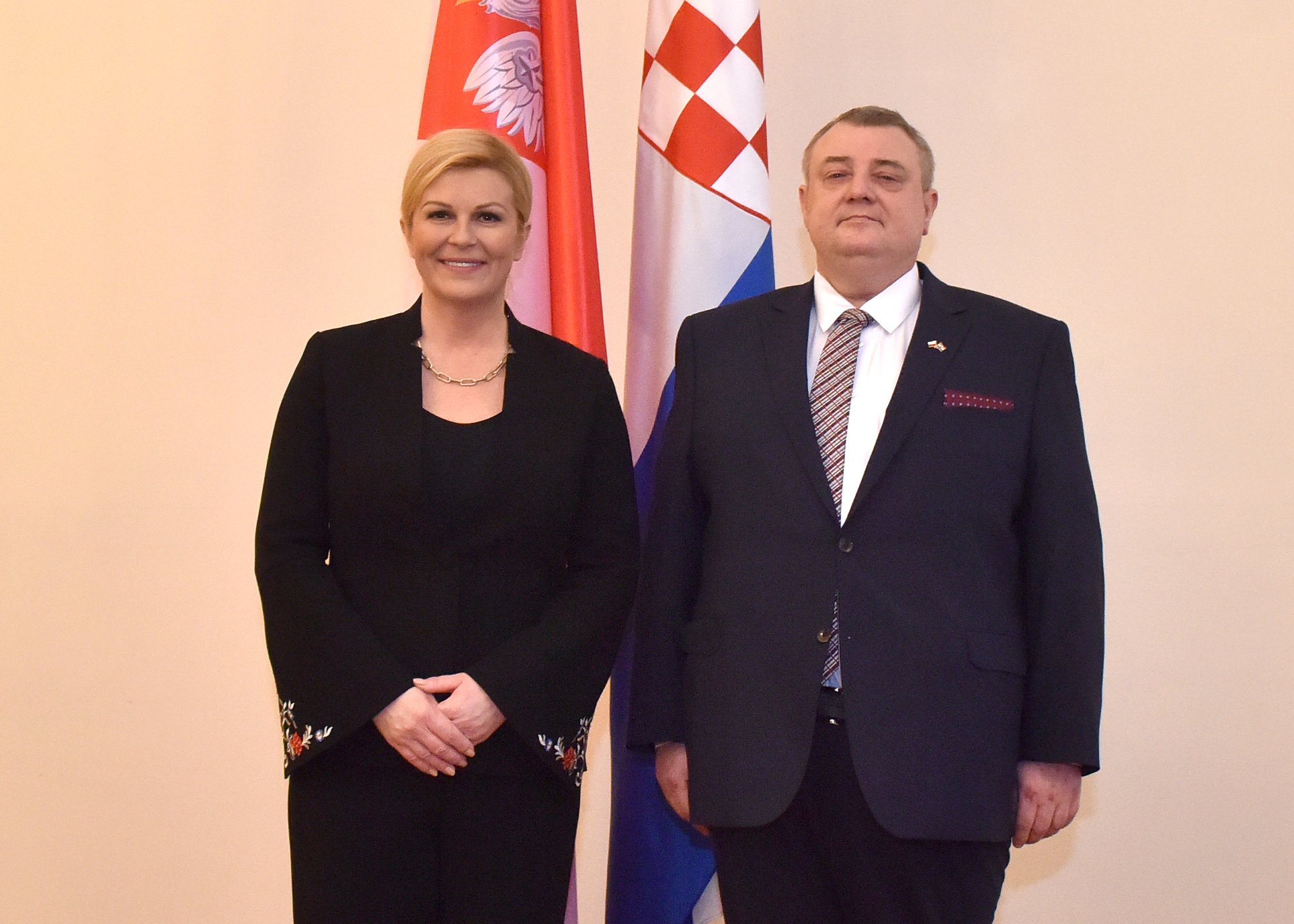
Polish Ambassador to Croatia Mr. Andrzej Edward Jasionowski, pictured with Mrs. Katarina Grabar-Kitarović in 2018 © Polish Embassy Zagreb
Meet HGSS The Croatian Mountain Rescue Service
August 19, 2020 – All weather, all terrain, all year round – meet HGSS The Croatian Mountain Rescue Service, amazing volunteers who will never let you down
They're never far from the news. For the last two weeks, members of HGSS The Croatian Mountain Rescue Service have yet again been on the TV news every night. They're leading the search for a summertime visitor, a Polish hiker missing on Biokovo mountain.
But, watch again this winter and, for sure, they'll be in the headlines once more. Whether, they're scaling mountain ranges in the unbearable heat of high summer, searching underwater caves, flooded rivers or the sea, breaking through wild forest or trudging through metres of snow, they undertake their search and rescue missions over every terrain, in every weather condition, in every month of the year, all across Croatia. And, they all volunteers.
Marc Rowlands meets the head of service for HGSS The Croatian Mountain Rescue Service and three of its volunteers to find out who they are and what makes them do what they do.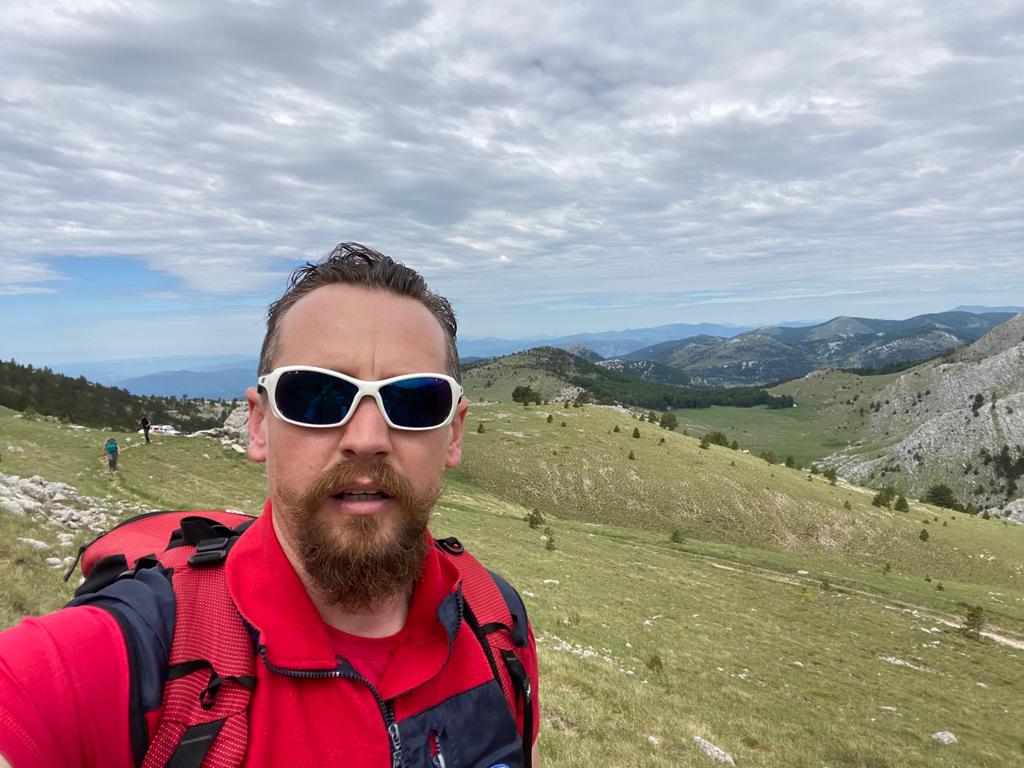
Josip Granić, head of service for HGSS The Croatian Mountain Rescue Service
My name is Josip Granić. I'm the Head Of Service for HGSS The Croatian Mountain Rescue Service. We've had an extremely busy couple of weeks. Being head of service for an organisation like this under such circumstances means you're always on the phone; co-ordinating, talking to outside organisations, members of the press. Communication. It's a 24/7 job, 365 days a year. If people need help, you can't take a holiday. Not at this level of the organisation.
We have around 1000 members. There are 11 paid positions in the main organisation and 25 people we pay to run the administration in each of the teams or stations we have. All of the members who perform the search and rescue are volunteers. We have pilots, surgeons, nurses, students, professors, every part of society.
I'm originally from Kaštela, but my home station is in Karlovac. I've been there for 15 years. I've been Head Of Service for two. Since I assumed the position, I've spent most of my time in the car. I travel all over Croatia.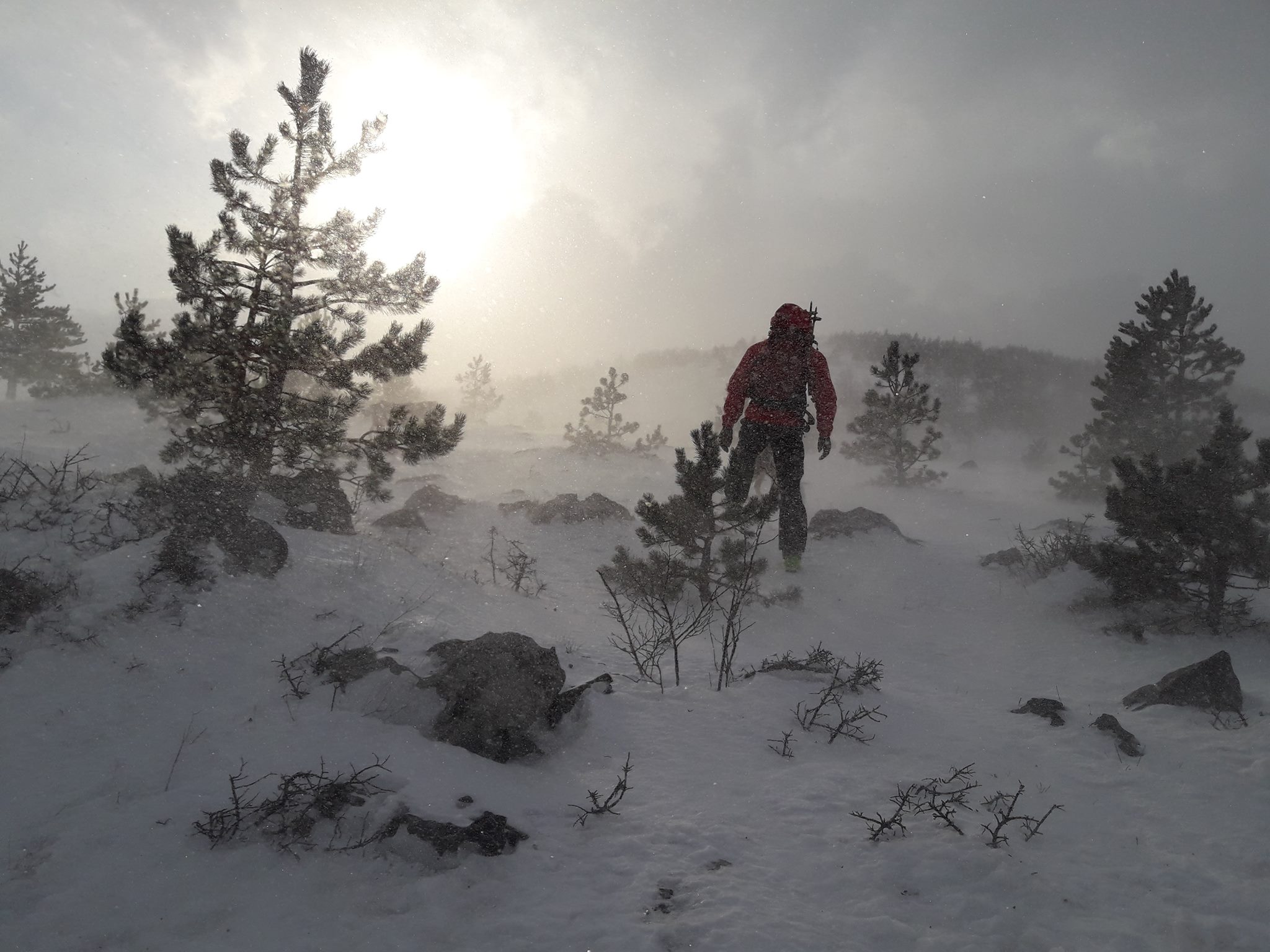
HGSS The Croatian Mountain Rescue Service missions can be hampered by extreme weather conditions © HGSS The Croatian Mountain Rescue Service
To get a certified position as a mountain rescuer in Croatia you all do the same training. It doesn't matter if you come from Slavonia, Dalmatia or Istria, you must have the knowledge and ability to deal with circumstances in any terrain; caves, pits, mountains, on snow, underwater.
Depending on where your station is, the type of call-outs you get could be very different. In Slavonia, 90% are for missing persons - searching forests, rivers, and in floods. We've had a big search on Biokovo mountain for the past 16 days. The stations from Split, Makarska, and Dubrovnik were at first involved, then teams from all over Croatia. It's not the same as Slavonia. The terrain is very different, so you have to be good at a particular set of skills. But, the largest percentage of call-outs is still missing persons. It's 70% of our work nationwide. The other 30% are rescues.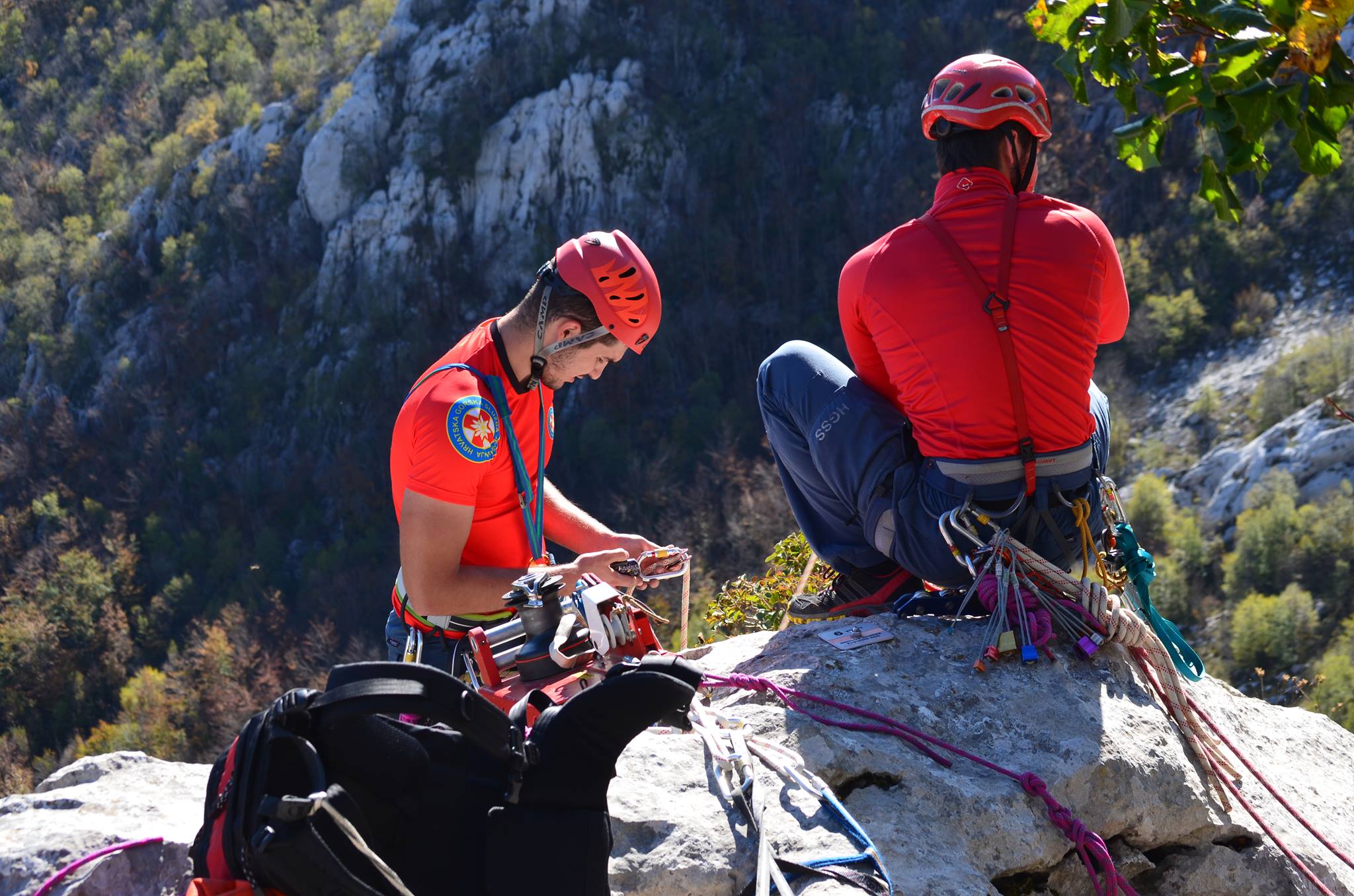
HGSS volunteers are educated to use a wide range of technical equipment. They are trained to operate in all the different kinds of terrain found across Croatia © HGSS The Croatian Mountain Rescue Service
There are usually 800 – 1000 missions a year across the country. We get roughly the same amount of calls in colder months as in warmer months. Only, winter months can be busier. The terrain is more difficult. There are some villages in Croatia – usually where the front line of the fighting was, around Karlovac, Kordun, Lika – and when it snows, it can be almost impossible to reach those places. But, some older people still live there. It can take days to reach them on snowmobiles, then skis, to deliver food or medecine. The other busiest places in winter are the ski resorts - Platak, behind Rijeka, and in Zagreb, on Sljeme. There are teams stationed in those places throughout the snow season.
What's the greatest danger of the job? Almost everything. Nothing in this job is easy. The greatest dangers we face are the same facing those that we rescue - underestimating the environment, nature, the conditions. That's where our training comes in.
In mountain rescue, we separate dangers into subjective, objective and technical. Subjective is the stuff you're guilty of - lack of preparedness, knowledge or equipment. Objective dangers are the ones you can't control, like sudden changes in weather, or avalanche. If you're sensible and informed, there should be no objective danger.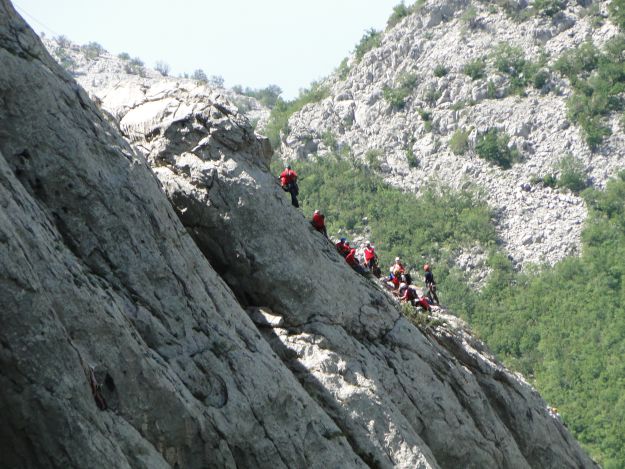
HGSS on a mission, clinging to a steep incline in Paklenica © HGSS The Croatian Mountain Rescue Service "People need to be aware at all times on the mountains. By the time most people think they may be in trouble, they've usually been in trouble for five or ten minutes already" Josip Granić.
80 – 85% of the people we rescue are Croatian. Only 15 – 20% are guests. People from Czech Republic, Slovakia, Poland, (Austria and Slovenia too) tend to enjoy nature more. They like hiking. That's the reason there are typically more rescues for those nationalities than there are for British, Belgian, French, Italian, America, Canadian or Australian guests. I don't remember the specific year, but sometime between 15 and 20 years ago we had a season where 5 or 6 Czech nationals were being searched for or, sadly, turned up dead. The media covered it and ever since there's been this myth that all the people who get into difficulty are Czech.
The question about expensive helicopter rides - why don't you charge the people you rescue - has been here forever. It's like this - if you're a tourist and you have a car accident in Croatia, the fire service, police and an ambulance will come. You won't get charged. We are a tourist country. According to international agreements, we are obliged to make everything safe for residents and guests alike. We are here, just like the fire service and police, to do our part. The Croatian air force is responsible for the helicopter rides and I have to give credit to them - they are crazy good pilots. Amazing. Even if we did charge everyone we saved - and most of the 85% of Croatians we save would struggle to pay - it still wouldn't be anywhere near the money required to run this service.
The Croatian Mountain Rescue Service used specially trained dogs on their searches © HGSS The Croatian Mountain Rescue Service
In 2007, I got a new search dog. It came from the Ogwen Valley Mountain Rescue service in North Wales. We cooperate a lot. We were sent out on a job to look for a three-year-old male child who had gone missing near Požega at the beginning of January, wintertime. His grandma was watching him and they were in a house on the edge of the woods. Early in the morning, he was playing with a dog. It suddenly ran into the forest and the boy chased after him. The grandmother didn't see it happen. I found him using my new dog, just after 8 o'clock the next morning. He'd been alone in the freezing forest for almost 20 hours.
Time is really moving fast on a job like that, because it's a kid and because it's so cold. Survival rates in such conditions are not good after 24 hours. When I found him, saw that he was alive, those big eyes looking up at me, it's a crazy feeling. You can't describe it. You can't compare it. A lot of positive emotions.
Every mission is special. We meet them all with the same level of determination and professionalism. But, it's the ones where you know you've really saved someone that stand out in the memory. Not the broken leg, where you transported someone – sure, that's an excellent job. But, when you know you've saved someone's life, that they definitely wouldn't be here now if it weren't for you, that's what makes it all worthwhile.
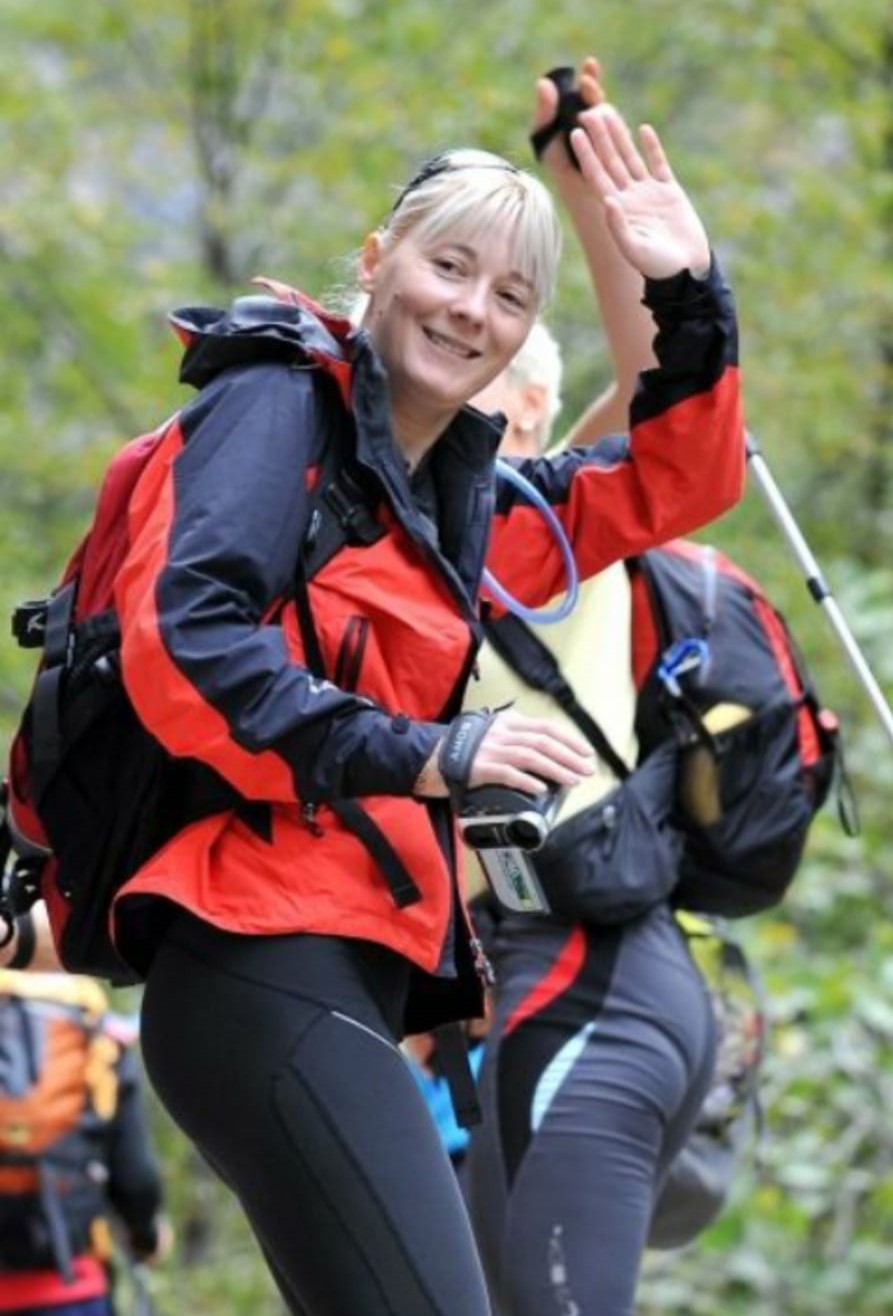
Jana Mijailović, volunteer for HGSS The Croatian Mountain Rescue Service
My name is Jana Mijailović, I'm 48 years old and I'm from Zadar. I finished school to be a teacher, but I never did it. My husband and I run a company that does plastic and aluminium windows for houses.
I started to go into the mountains when I was at high school. I never had the ambition to be part of mountain rescue services – people just noticed me on the mountains. They said I'd be good at it and asked me to join. I met my husband on the mountains. We are both volunteers for HGSS The Croatian Mountain Rescue Service. I've been doing it for 16 years.
I was a member of the first and second all-female Croatian expeditions to the Himalayas. We first climbed Cho Oyu in 2007, then Mount Everest in 2009. Croatia is the only country in the world that has only one successful male climber of Mount Everest, but four successful female climbers. I sometimes work as a guide too. I guess you could say I'm all about the mountains.
Being a climber, an Alpinist, I know that if I get into trouble, it's only my HGSS colleagues who can help. I feel this instinctively. I cannot be in the house, safe and warm, knowing that maybe someone needs help that only I can provide.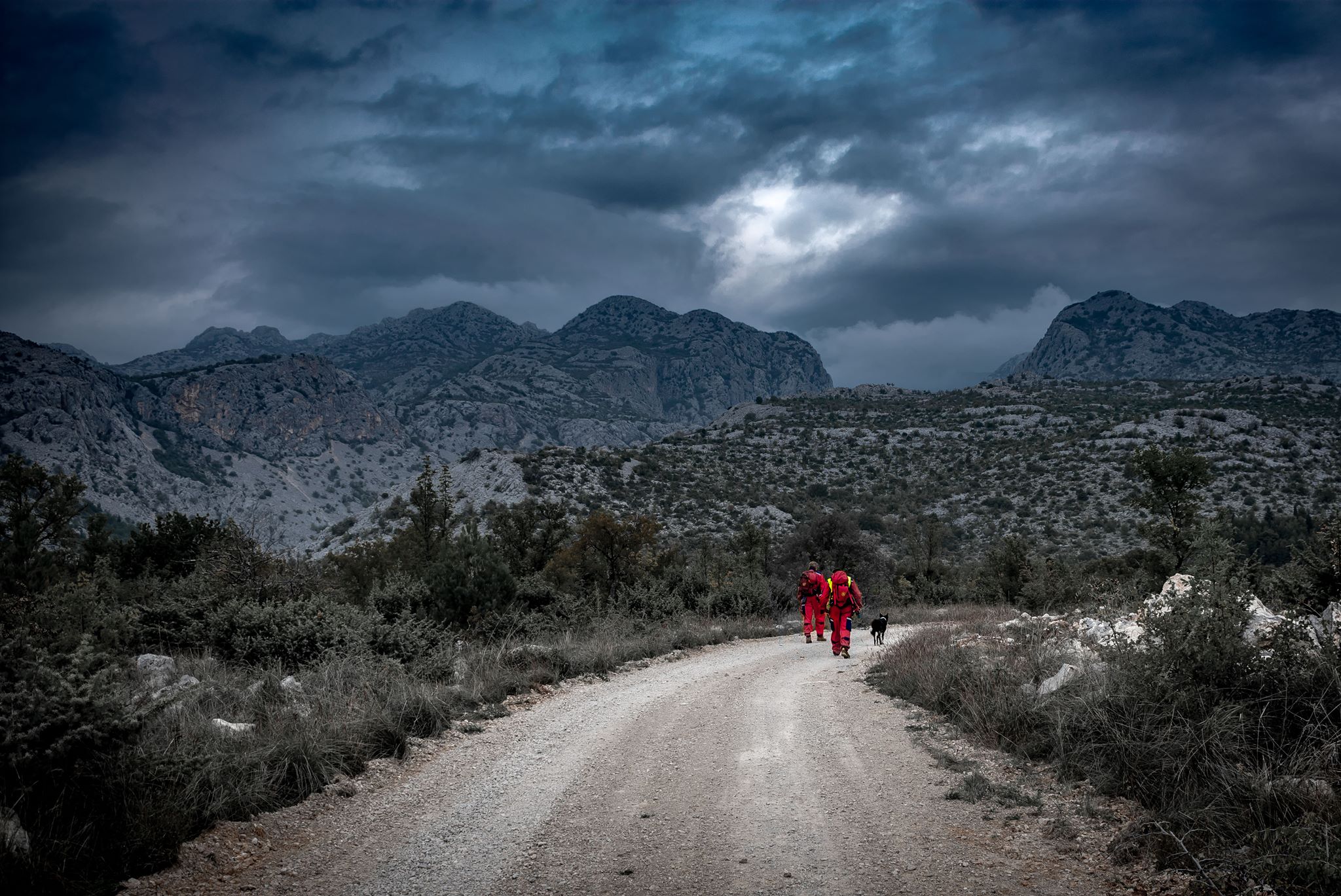
HGSS The Croatian Mountain Rescue Service members entering Paklenica under foreboding skies © HGSS The Croatian Mountain Rescue Service
I've really been on so many expeditions with HGSS. My station are on duty in the season at National Park Paklenica and I'm now the coordinator. Climbers from all around the world come and so there are many interventions. None of them are easy because the terrain is incredibly difficult. You really have to be in shape and know the techniques inside out.
I'm very proud of my statistics. Everyone I've rescued, who was alive when I reached them, is still living today. Unfortunately, not everyone we reach is alive when we arrive.
I remember one time, my husband and I were having dinner. We were arguing about the techniques and knots for moving a stretcher down a vertical climb. The training is so intense, you really have to know it well, and I guess that's just the kind of people that we are, that we would be arguing about it in our free time. Ha! He told me, "Why do you care? You'll never have to do that," because usually, it's really strong guys who do that specific job. If you're on a 400-metre-high section of rock, it really takes a lot of muscle.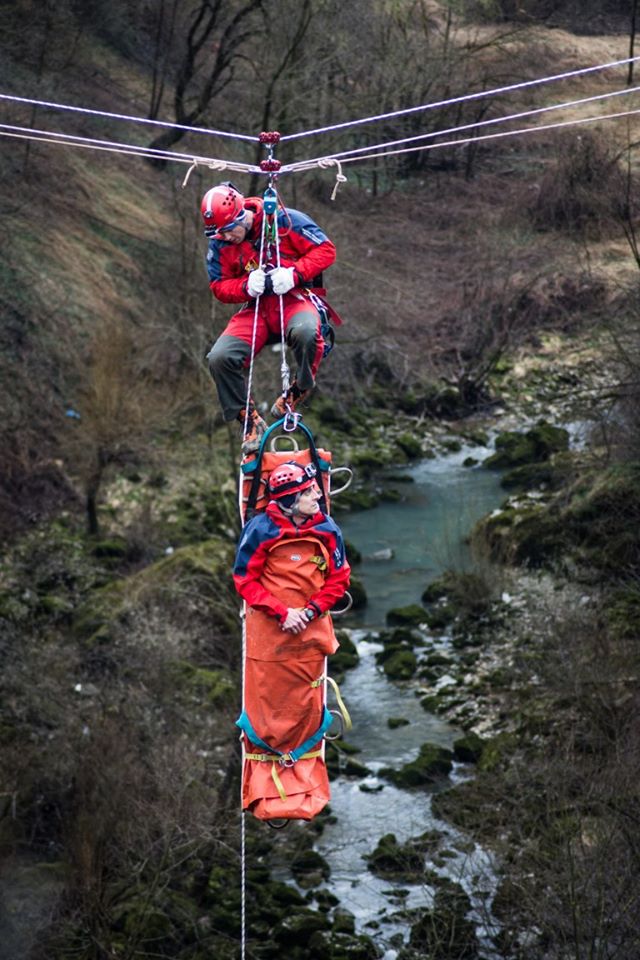
Ascending from a valley floor or descending from a mountain peak with a stretcher is a technically difficult operation, often hindered by darkness and adverse weather conditions. It requires a lot of training and a lot of muscle © HGSS The Croatian Mountain Rescue Service
In the evening, just two days later, we were called out to rescue an Italian guy who broke his leg on Anića Kuk. It's a really mighty part of the stone. And the leader of the expedition asked me to go on the stretcher. They pull you down on the ropes and you have to push very hard to keep the stretcher, the person you're carrying and yourself away from the rock, while balancing the weight of all three. It was dark, raining and with lots of Bura, the incredibly strong wind that sometimes hits us. That's probably my most memorable rescue.
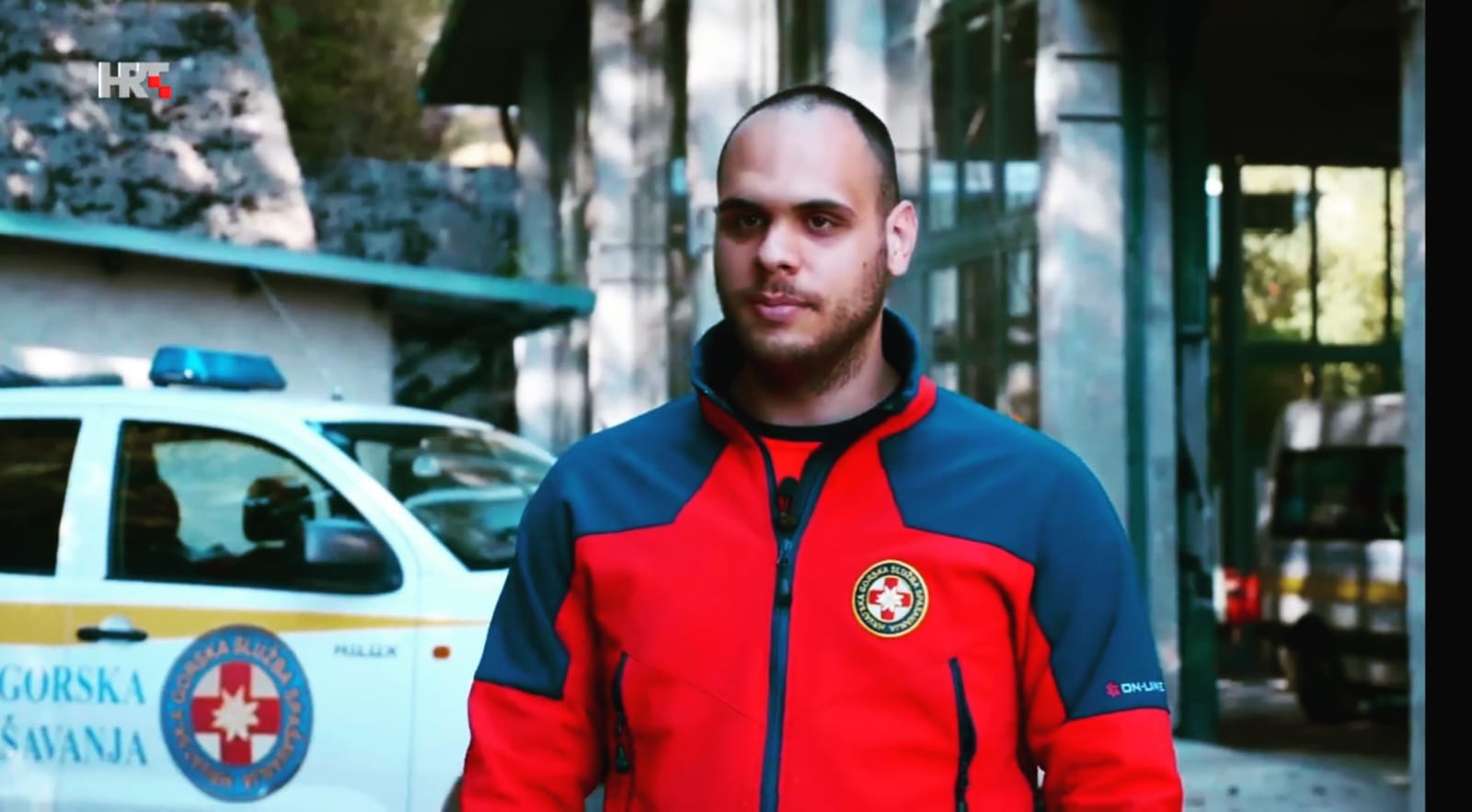
Petar Prpić, firefighter and volunteer for HGSS The Croatian Mountain Rescue Service
My name is Petar Prpić, I'm 25 years old and I'm from Hrvatska Kostajnica, just on the Croatian-Bosnian border. My station is in Novska. In my full-time job I'm a professional firefighter. I guess I have two dangerous jobs. Well, one job and one hobby.
I've always been interested in the outdoors – mountaineering, hiking, canoeing. But, that's not why I joined HGSS The Croatian Mountain Rescue Service. I just wanted to help people. I don't know, I guess it's just something in me.
We have a lot of rivers in our area. During the times of flood, we get a lot of call-outs. Our part of the country has a high percentage of elderly people in the population. A lot of them live in small villages, on the edge of the forest. We get a lot of call-outs for searches. Especially in the autumn when people go out looking for chestnuts or mushrooms. But, like all the stations in Croatia, we are here year-round if there are any actions in other parts of the country that need us.
In some areas, HGSS The Croatian Mountain Rescue Service are frequently called out in response to flooding. This picture shows HGSS members on operation during the 2014 floods. In that year, flooding across the whole region was so bad that HGSS members operated not only in Croatia, but also donated their services to neighbouring Bosnia and Serbia © HGSS The Croatian Mountain Rescue Service
I was just on the search in Biokovo. The head of service called me and asked me to go. I first had to get some free days from my job. I called my boss, Zvonimir Ljubičić, chief of the fire department. He's great, very understanding, and he gave me permission. Two years ago I was called to Rab. Very hard operation, very difficult terrain.
Late last summer, we were called out to look for an older man near Glina. It was around 11 o'clock in the evening. He'd gone to look for mushrooms in the afternoon and never came back. Police were there and they sent for us.
The man had a cell phone on him, but there was no signal. There was no location given off the phone. We were a team of four, split into two teams. We went up into the woods above Glina and concentrated our search on areas where we could see there was no telephone signal on our phones. We were yelling in the dark. After an hour of search, someone answered. He'd been missing since 2pm. We found him at 2am. He was just lying there, uninjured but unwell, unable to move.
The reason it sticks in my mind is that the next day, in the morning, his daughter called me. She was so thankful, so emotional. For sure we saved his life. None of the other emergency services who were present could find him. It was down to us. We finished the operation at about 6am and then all four of us had to go immediately to our regular jobs.
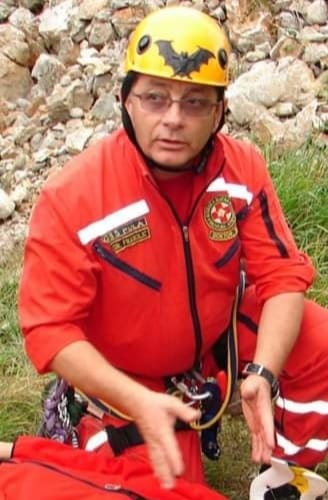
Mario Franolić, physician, ex-commando and volunteer for HGSS The Croatian Mountain Rescue Service
My name is Mario Franolić and I'm 60 years old. I'm the chief of the mountain rescue service in Istria. I travel throughout Croatia because I'm also an instructor for the medical commission of HGSS. I was born on island Krk. I'm based in Pula although I work in Rijeka. I travel a lot between the two. I've been with HGSS The Croatian Mountain Rescue Service for 18 years.
In my day job, I'm a physician. I am a senior mentor at the Institute for Underwater and Hyperbaric Medecine in the Clinical Hospital Rijeka. I'm an expert in my field of emergency medecine. I've been doing it for almost 30 years.
When I was young, I trained to be a physician in Belgrade. It was then the best medical faculty in Yugoslavia. At the same time, I also started spelunking (cave exploration). I've been doing it since 1978. Later, I was a physician in the military underwater commando unit. I lived in Austria for five years, but when I came to Pula, they were just starting the HGSS The Croatian Mountain Rescue Service station here. They asked me for help because they didn't have any medical professional on the team. I accepted. It would be a waste not to use all these skills I have.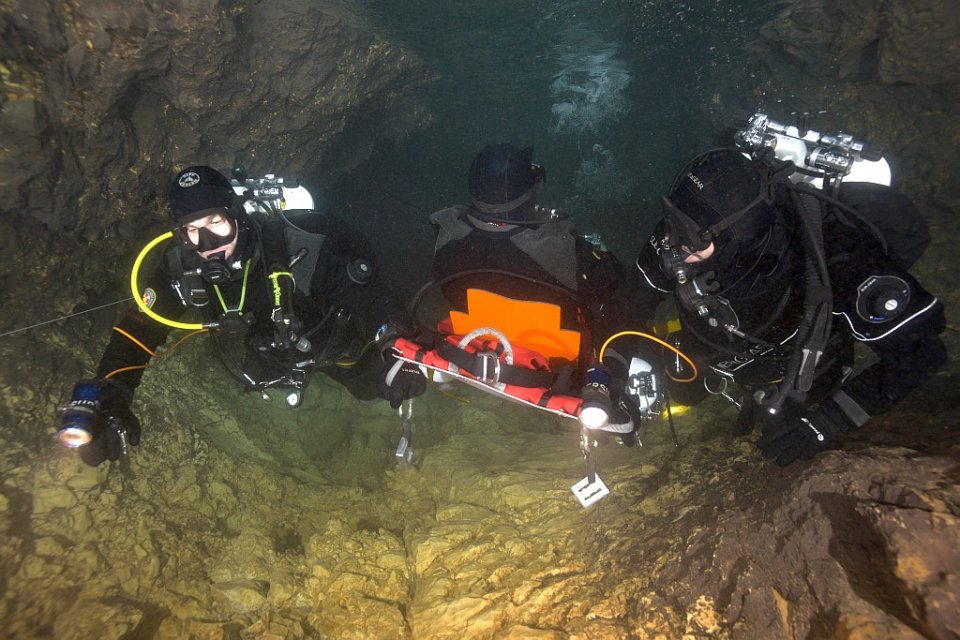
Specialist teams from HGSS are trained in underwater rescue from caves. Such caves exist all over Croatia in the karst rock, and also on some islands © HGSS The Croatian Mountain Rescue Service
Sometimes, our status as volunteers can give us problems. Although we have official duties, we are more like an NGO than something like the police. There can be legal implications. I remember one situation, very acute because a paraglider fell from the sky. None of his colleagues saw him fall. Paragliders go into the air together, but then they each branch off to do their own thing.
We had no idea about the location. We started from the last point of sighting, knowing that it could be very far from the place where he actually fell. But, we had to start somewhere. We had one mobile phone signal direction. But, you need three in order to locate someone. We only had a line on the map.
In the past, HGSS The Croatian Mountain Rescue Service sometimes had difficulties because the telephone companies wouldn't give us the information we needed in order to triangulate the position of a missing person. They would only give it to the police. But, it's a race against time. We searched for this man all day and all night. In the morning, some Croatian paragliders made private contact with a guy from the phone company. They begged him to release the information we needed. Although he could lose his job, giving such information to private citizens, he did it.
We found the man about 150 metres from where we were. Sadly, he was already dead. It was very small comfort to see that he had died instantly, on impact. It's unbearable when you reach someone you could have saved if only you had got there quicker, especially in an instance such as this, where we were hindered by a lack of information that was available. I think it moves more quickly now, but still we have to go through the police.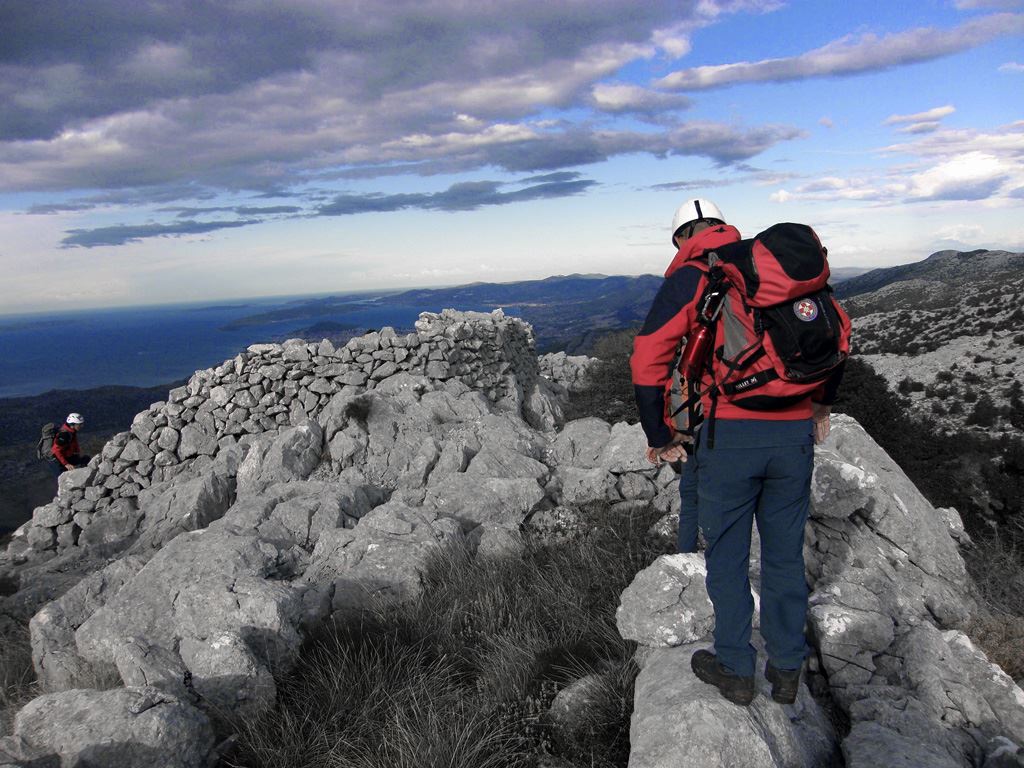
© HGSS The Croatian Mountain Rescue Service
One of the most emotional operations I went on was around five years ago, the rescue of a young girl - maybe two and a half to three years old – who got lost in the woods in a small place in central Istria. She chased into the forest after some dogs around 10 or 11 in the morning. The family saw immediately that she had disappeared and started to search. About two hours later, we were called out. It was impossible for the family to find her.
About 300 people came – my station, the Rijeka station, hunters, firemen, police and volunteers. In such an operation, the police are the lead service. But, 99% of the time they leave the organisation of the search to HGSS The Croatian Mountain Rescue Service. We are the only organisation who is very well educated in organising searches. When other people do searches, they use intuition. But, people all have different intuition. It can be chaotic. We are highly trained for this. There are procedures, recognised internationally, that we follow. We found her early in the morning, at around 7 o'clock. The dogs were lying on each side of her, giving her warmth.
All photos courtesy volunteers and HGSS The Croatian Mountain Rescue Service
HGSS to Celebrate 70th Anniversary in April
ZAGREB, February 25, 2020 - The Croatian Mountain Rescue Service (HGSS) said on Monday it would celebrate its 70th anniversary in April, and Assistant Minister for Civil Protection Damir Trut announced the completion of the project which would provide civil protection services with five helicopters for medical and rescue operations.
"The Ministry of the Interior and the Civil Protection Directorate have designed a project to provide the civil protection system with five helicopters. I expect financing documents to be signed by the end of the year so that we can begin the procurement process for three medium-sized and two large helicopters, which would be used for emergency medical transport and mountain rescue operations," Trut told reporters.
HGSS chief Josip Granić recalled that the HGSS was founded in 1950 by four founders and several members. "Today we have 1,018 registered members, and the increase in the membership means an increase in the number of activities," he added.
"Since the foundation of the HGSS we have saved several thousand people. The HGSS has between 800 and 1,000 response operations annually. In some we saved a large number of people and in others animals or equipment," Granić underscored.
He said that during the 70 years of service they have gained enough experience and knowledge to be able to continue their work with confidence, especially since there will always be a need for rescuing people.
"Because of the increasing number of people spending their time in nature, accidents will, unfortunately, happen more and more often," Granić said.
He noted that rescue equipment was expensive but that the support by the local community and the government continues to grow every year.
"Rescue equipment used in all circumstances costs around €10,000 (€1,350). Not everyone has all the equipment, which may not even be necessary, but we need to make sure that everyone can respond at all times," Granić said.
The HGSS is financed with about HRK 30 million (€4m) annually, of which HRK 17 million (€2.3m) is provided by ministries and through various grants.
"It is important that we receive almost exactly the same amount of funding from EU funds. We apply for projects all the time and we'll have to do so even more," Granić underscored.
HGSS secretary-general Darko Berljak announced that there would be a major demonstration exercise for the public at Zagreb's Lake Jarun on 10 May. "We also want to act preventively so we are going to organise a series of exercises and workshops throughout the year in all our 25 stations in Croatia," he said.
More news HGSS news can be found in the Lifestyle section.
Croatian Mountain Rescue Service Accepts Tetris Challenge from Army!
The Croatian Mountain Rescue Service (HGSS), made up of volunteers who work hard and tirelessly rescuing would-be mountain climbers, Olympic swimmers and other unfortunate individuals who misjudged the height of that mountain or the distance between the mainland and a ''nearby'' island, have become somewhat well known for their sarcastic social media posts and their funny approach to life in general.
Over the last couple of years or so, HGSS has delighted those on social media with many amusing posts in their attempts to warn tourists from tackling mountains in mid August in flip flops, from getting carried away by a current when on giant pink flamingo inflatables, or from attempting to swim from island to island. The list goes on, and the team of volunteers has come face to face with both amusing scenarious and dangerous ones.
The main bulk of ''events'' take place during the summer tourist season, but HGSS are ready all year round to step in and save people from potentially dangerous situations across the entire country.
Now, as Morski writes on the 13th of October, 2019, the witty team of the Croatian Mountain Rescue Service responded to a rather unusual tetris challenge from pilots and technicians from the Croatian Army after they had done it with the OH-58D Kiowa Warrior helicopter.
''Our most valuable equipment is our 1,000 volunteers, and our best drive is... our legs,'' the Croatian Mountain Rescue Service wrote on their official Facebook profile, where they posted two photos.
On one, they are in a "tetris" position, on the other, there is both equipment displayed with a symbolism which means that they are ready to do their praiseworthy jobs 24 hours a day, seven days a week and 365 days of the year.
This interesting challenge was apparently initially created by employees from the Directorate of Civil Protection at the Ministry of the Interior (MUP).
Make sure to follow our dedicated lifestyle page for more.
Croatian (not really a) Pet of the Month: Draco from HGSS
Of course, we're aware of the fact that Draco is not a pet, he'd probably be very insulted if he understood the implications of that word. What he is, is a working dog, a highly esteemed colleague to the men and women working in the Croatian Mountain Rescue Service (HGSS), a six-year-old search and rescue dog with the record of nine (!) people found in his SAR career!
Kruno Stipetić trained Draco to work with him for the Croatian Mountain Rescue Service, although when Draco first came to him back when he was still a puppy, it didn't seem like it was going to be such a success, Bogdan Blotnej writes for 24sata. Nobody worked with Draco on basic commands and training, so they had to start his training from scratch, and it took them two years of hard work and training for Draco to become a licensed SAR dog.
He passed the HGSS test, which is considered to be one of the most difficult in the world. He's licensed to perform search and rescue in collapsed buildngs and in avalanches, but luckily, neither of the two happen often in Croatia, so he helps with other SAR missions as well. Recently on Pašman more than a hundred people searched for a missing woman for over two days. It took Draco around half an hour to find her, alive and well.
Although he's only six years old, he appears somewhat older to those who meet him first - probably because of the grey hair on his snout, but also because of the serious demeanor and obedience. Mr. Stipetić says that the grey hair might be because Draco feels the strees of his job, and that his hair started turning grey when he was only 3.5 years old.
He takes his job seriously, never gets scared (even when on a mode of transportation that he's not used to), enjoys snow and stays focused until his work is completely done. Sometimes he finds people that have been lost and they are so happy to see him that they start petting him immediately and thanking him for his help. That confuses and disturbs him, because he knows that his job is not over until he manages to get HGSS people to find both him and the person they were looking for.
HGSS has named Draco officially the most succesful SAR dog in Croatia, because of his nine finds in his career, where on average such a dog manages to find two or three people in their career. After each succesfull mission Draco gets a reward for his hard work - he gets to play with his ball, which is for him more important than the food is sometimes!
Find the other winners of the title "Croatian Pet of the Month" here.
HGSS to Tourists: We've Been Messing with Natural Selection Since 1950
The Croatian Mountain Rescue Service (HGSS) has become very well known over the last couple of years for their amusing, sarcastic social media posts aimed at foreign tourists visiting Croatia who fancy themselves as mountain climbers, hikers and long distance swimmers during the sweltering July and August heat.
While HGSS's reign has mainly been on Facebook and Twitter, with numerous funny, perhaps slightly passive aggressive posts from the team of tireless volunteers who save many a foreign tourists from sticky situations which could have ended horribly each and every year, it seems that they've taken to new extremes when it comes to issuing their comedy-clad warnings.
Taking special aim at their favourite selection of people, those in flip-flops, HGSS has decided to go one step further than social media, and has placed giant billboards along busy main roads to warn would-be bravehearts against being heroes.
As Morski writes on the 3rd of July, 2019, HGSS doesn't just post comical statuses and photos, but saves hundreds of lives per year, particularly during the height of the summer tourist season, and also invests heavily in prevention. What better way to prevent a potentially horrendous accident or death than with enormous billboards and signs placed along the roads used by hundreds of thousands of foreign tourists who have driven to Croatia for their holidays?
"Dear tourists, we have been messing with natural selection since 1950, at least you could play along and take care of yourselves and others," reads the poster, accompanies by an illustration of a well-trained and properly equipped hiker, with the more serious statement included, that clothing for such ventures should ideally be watertight.
On the other billboard, a very simple message for would-be summer "hikers" reads: "We respect you, please respect yourselves and hike responsibly." Along with a drawing of water bottles, battery lamps and fully charged mobile phone batteries.
Follow our dedicated lifestyle page for much more.
HGSS Rescues Two Tourists, Writes Sarcastic Facebook Status
The Croatian Mountain Rescue Service (HGSS) is known for its amusing and rather sarcastic posts and images on social media aimed at tourists who fancy having a crack at tackling mountains like Sv. Ilija in a pair of cheap flip flops, attempting to swim to ''nearby'' islands that are a lot further away from the mainland than they first appear, or having a go at mountain climbing up Biokovo or Velebit at 14:00 on a boiling hot August day with all but a half filled bottle of Jana water.
The height of the tourist season in Croatia has only just begun, and with that, the tireless group of volunteers which make up the body of HGSS have started to receive calls, mainly from foreign tourists who underestimated the power of nature, not to mention the strength of the summer sunshine, and grossly overestimated their physical abilities.
As Poslovni Dnevnik writes on the 1st of July, 2019, HGSS's Gospić station recently announced on their Facebook page that they have successfully managed to rescue two foreigners. The post doesn't mention which country the unfortunate pair come from.
"During the evening hours, two foreign nationals were rescued from the rocks above the bay of Zavratnica... try to guess which footwear they were wearing!" writes HGSS in a Facebook post which was consequently commented on by numerous people taking guesses, with the notorious flip flop being the most likely culprit.
Otherwise, HGSS has recently warned would-be adventurers that they absolutely must have the minimal equipment with them at least, such as more than enough water, a proper lamp or torch, and a full battery.
In addition, with their typically comical statuses and various creative signs, HGSS warned foreign tourists strictly against using summer footwear, such as flip flops, for mountaineering. Of course, many don't bother to take heed or listen and thus increase their chances of needing to be rescued by the good people of HGSS.
Make sure to follow our dedicated lifestyle page for much more.
Croatian Mountain Rescue Service (HGSS) Publishes More Amusing Warnings
June the 15th, 2019 - the Croatian Mountain Rescue Service (HGSS) has become known over the last couple of years or so for its sarcastic, witty warnings to tourists who might fancy tackling mountains like Sv. Ilija in a four euro pair of Primark flip flops in the middle of the scorching August heat.
Recently HGSS asked tourists to please Tweet them if there is indeed life after death, accompanied by a fitting yet morbidly funny pink inflatable in the shape of a coffin.
From warning tourists not to try to swim to ''nearby'' islands, which are in actual fact much further away from the mainland than they first appear, to making sure they don't get stuck and dehydrated halfway up Biokovo at 14:00 on a boiling hot July day, this group of tireless volunteers are very inventive in coming up with their amusing warnings to foreign tourists planning on spending summer along the Croatian coast.
Using the hashtags #nomeansno and #isurvivedaholidayincroatia, HGSS have taken to social media once again just before the main tourist season begins to make sure that there are definitely no language barriers and misunderstandings among those who don't understand the Croatian language.
Dear tourists, we know you don’t speak Croatian, so please follow the obvious wordless signs while hiking in the Croatian mountains reads the recent post from HGSS on their Facebook page, along with a photo that can hardly be misinterpreted, even by the ''bravest'' (or indeed most stupid) of tourists this summer season.
In all seriousness, HGSS is made up of volunteers who are forced to deal with idiotic and often highly dangerous situations each and every summer in the Croatian mountains. The majority of these incidents are entirely avoidable and are unfortunately the product of bad decisions made by foreign tourists. Make sure to take all of the necessary precautions if you're planning on a bit of mountaineering or swimming this summer in Croatia!
Make sure to follow our dedicated lifestyle page for much more.


